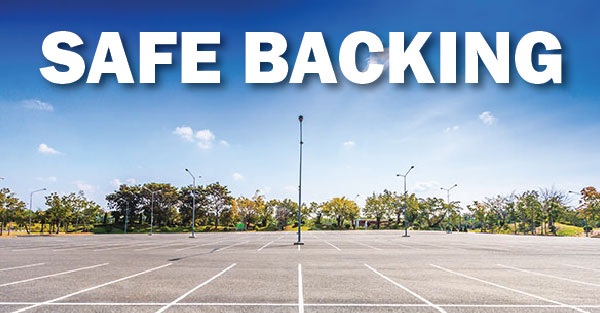
Parking lots can be a risky place. Tens of thousands of crashes occur resulting in hundreds of deaths and thousands of injuries. Nine percent of pedestrian deaths in parking lots are a result of backing incidents.
The best way to avoid a backing accident is to avoid backing, if possible. We know that isn’t always possible, so these general guidelines are provided to help make backing safer. Other backing situations may require additional procedures.
GOAL: Get Out And Look prior to backing.
- Plan ahead; know your stop ahead of time to recognize the need to back.
- Back first; do not stop to perform other tasks once you are in position to back. Pedestrians or other vehicles may attempt to go around you and enter your blind spots.
- Never back while talking on a two-way radio or cell phone. Turn off radios, heater, air conditioner fans, etc., and roll your window down, so you can hear what is going on around you.
- Check the area for uneven surfaces, potholes, wheel chocks, fixed objects and debris. Any uneven surface can be enough to cause the trailer top to strike a close object.
- Make sure your travel path is clear of all obstructions along the sides and overhead too. Check for vehicles alongside you, their open trailer doors, fences and gates, awnings, ladders, standpipes, overhead wires, etc.
- Secure your trailer’s swinging doors.
- Situate your vehicle in the best possible position to begin backing. Set up your approach so you can back using your sight side (driver’s side) and minimize the amount of turning.
- Warn others you are beginning to back by telling them in person or by using your horn, four-way flashers, backup alarm and/or by placing reflective triangles around your truck to alert approaching traffic where appropriate.
Use these guidelines during backing:
- Back slowly. Use the lowest possible gear, or idle speed, and do not accelerate. A good rule of thumb is to back at a normal walking pace, this gives you time to react to your surroundings.
- Be aware of hazards, such as pedestrians or other vehicles, which might move into your backing path.
- Use a reliable helper to block traffic if necessary.
- If you must back around a corner, stop, get out and check what is around the corner.
- When absolutely necessary to back a long distance, get out to recheck your path frequently.
Use a reliable, well-trained guide (or spotter) whenever possible. Establish the hand signals you will communicate with, especially the “STOP” signal. The guide should be able to see the rear of the truck, the travel path (especially the passenger side) and you. Always keep the guide in sight. If any part of the guide disappears, stop immediately until you can completely see the guide again. Never let the guide stand between the rear of the trailer and what you are backing to. The guide should wear a reflective vest. At night, the guide should also carry a traffic control flashlight. Remember, you remain responsible for safely backing your vehicle, even if a guide is used.
Categorized in:
ClickToAddCategories
No categories have been created yet.
Community
Company Updates
Driver Recruitment
Investor News
Transportation Safety
Claims
Driver Management
Driving Techniques
Distracted Driving
Seasonal Driving Tips
Sharing the Road
Health & Wellness
Injury Prevention
Regulations
Security & Cargo Theft
Vehicle Inspections
Weather Conditions
Workplace Safety
Workers Compensation
Done